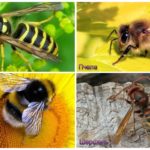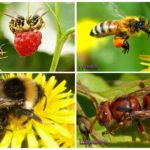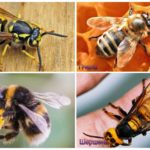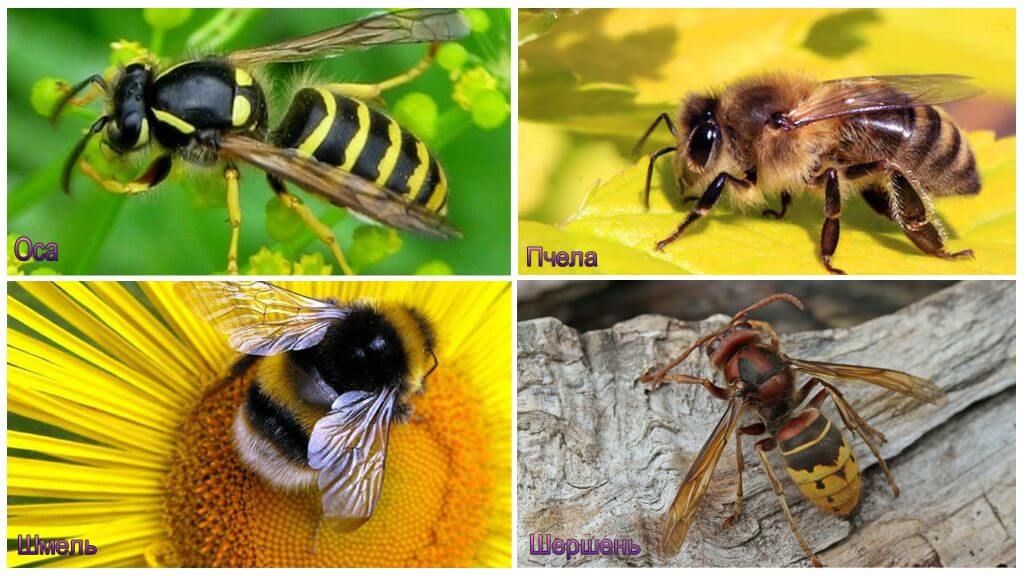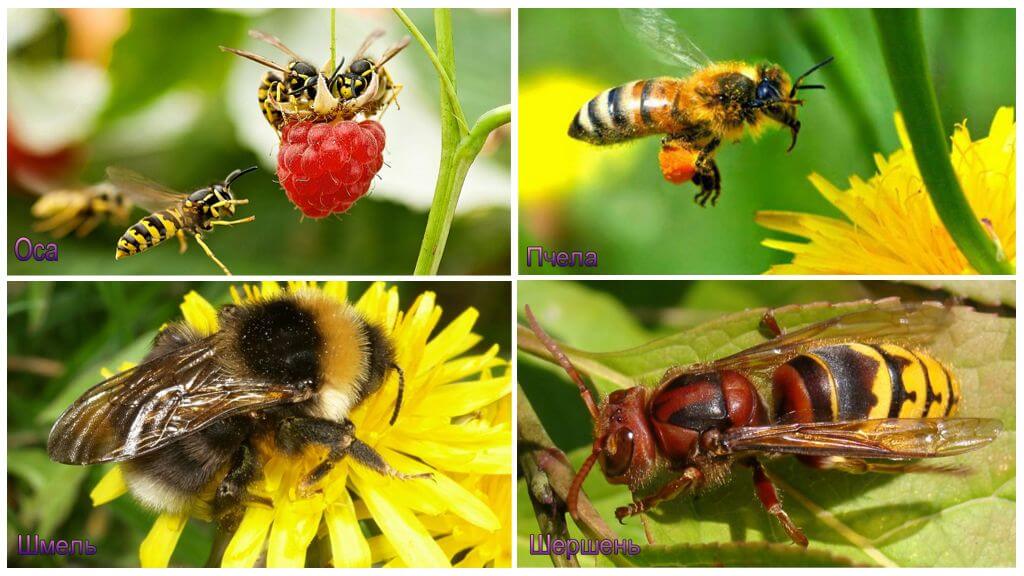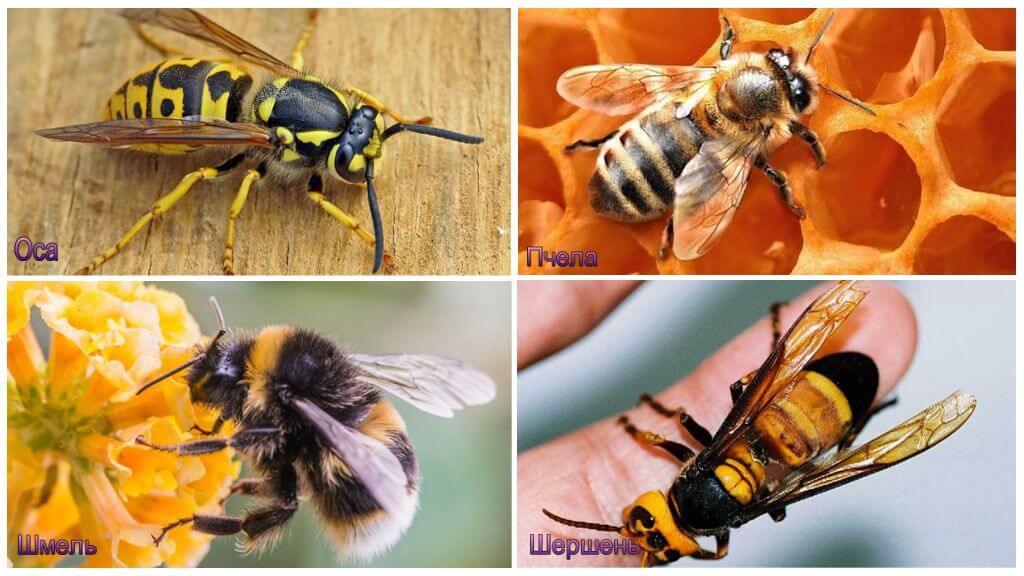What is the difference between wasp, bee, bumblebee, hornet
- Difference of a bumblebee, hornet, wasp, bee
- Difference of a bumblebee, hornet, wasp, bee
- Difference of a bumblebee, hornet, wasp, bee
Going in summer to rest outside the city, there is a high probability of meeting with stinging insects. The whales are especially annoying when there are sweet dishes on the table. And when trying to drive away an “uninvited guest,” the insect can take revenge on the offender by inflicting a painful bite. Sometimes such attacks are very dangerous. It all depends on whose attention was attracted to the sweet treat. So honey producers are relatively friendly and attack a person only in case of a threat.More aggressive character differ hornets and waspstherefore, you should not neglect caution when meeting with them. What is the difference between wasps, bees, bumblebees, hornet, help this article to understand.
What do they look like
To determine if the hornet is a wasp or a bee, attention should be paid to the appearance of the insects.
- The most discreet black and yellow color in bees. Their furry body is distinguished by harmonious proportions and the absence of abrupt interceptions between the belly and chest. Honey makers have small jaws, black comparatively thick and hairy legs.
- Osu can be recognized by a sharp transition between the thoracic and abdominal regions, as well as a smooth, thinner and elongated body. The insect has a bright contrasting color: on the black back there are yellow blotches, the back segment is painted in black and yellow stripes, yellow in color and limbs. The gnawing-type oral apparatus is distinguished by impressive mandibles.
- Bumblebee much larger than the brethren described above. Differences of a bumblebee from a bee and a wasp not only in the dimensions of the body, but also in the furry cover. The bumblebee is also distinguished by wide stripes of yellow-red or slightly reddish color. Sometimes found bumblebees and black color.
- Hornet - the largest (about 5 cm) of the above insect is the owner of powerful jaws. Outwardly, the giant resembles a wasp, but not with such a narrow waist.
Nutrition and Lifestyle
Bees feed exclusively on pollen and nectar. They do this with the help of a long proboscis. No less like floral nectar hornet and bumblebee. In addition to him, hornets feed on various sugar-containing berries and fruits. Also they eat small insects, including bees, successfully coping with a weak opponent with powerful jaws. Known cases of attacks of hornets, even on small animals.
Wasps are similar to hornet predators and aggressors. However, they will never dare to attack a bumblebee or another major opponent. To fight with the bees they are quite capable. But the victory in such battles is still more often achieved by honey producers adapted to the aggression of the offenders. Favorite treat for wasps there are also ripe fruits and sugar-containing dishes (jams, syrups, honey).
Interesting!
And bumblebees, and bees, and wasps are social insects that lead a gregarious way of life.However, bumblebees go looking for food one by one. Moreover, they try to collect nectar before other hymenopterans, who are still in the stage of sleep. In search of food "laborers" can spend up to 18 hours a day. Bees fly out in small groups, but flocks of wasps can total up to 3 dozen individuals.
Hornets workers go in search of food also one by one, overcoming decent distances (up to 10 km) for this. And if suddenly one of them succeeds in detecting a beehive, a “mark” is placed on it with the help of an odorous secret, which will later allow to return to the desired delicacy with its brethren. Hornets kill bees in a rather cruel way. They bite off their heads and limbs, biting into the body of the victim, striving to get to the valuable meat. However, the main prey in the beehive is still honey, they love to eat it and wasps. It is for this reason that bees and hornets or wasps cannot exist next to each other.
Habitat
It is clear that the place of residence for domestic bees are the hive built by man. Wild members of this family (wasps) prefer to build nests in the hollows of trees. Bumblebees look for more secluded places, building their houses in the ground, less often in birdhouses and tree trunks. And those and others are found in the fields and villages, they can also be found in city parks and botanical gardens.
Hornets build nests in rock crevices, in hollows and on tree branches, as well as under the eaves of buildings. Almost everywhere they are built by wasps. The house of stinging insects can be located on the stalks of plants, in the branches of bushes, and in the attics of baths, sheds or verandahs. Biting off pieces of wood from wood, they moisten them with their saliva, as a result of which the building material becomes like heavy paper.
Who bites harder
People quite often become victims of stinging insects, in connection with which, often the question arises, who bites more painfully: wasps, bees, bumblebees or hornets.
On a note!
The most aggressive are wasps and hornets. These insects have a smooth sting that can pierce the skin of their prey several times. Moreover, the offender himself in this situation is not in danger. Hornet bite and the wasps are accompanied by severe pain, burning sensation and swelling. More toxic composition is different poison of the hornet (especially Japanese). The consequence of such an attack can be a strong allergic reaction, and even death.
The bee is able to sting once, as it leaves its sting in the body of the victim. The attack weapon is prevented from hitting back, as a result of which the insect loses some part of its body and soon dies. Therefore, bees sting only in exceptional cases. If you look for the difference in who stings more, then bee sting less painful than wasp or hornet. In addition, when a danger arises, both the bees and the wasps are capable of giving a distress signal to their relatives, as a result of which the entire swarm is attacked by the offender.
Bumblebees are less controversial in this respect and attack their victims in exceptional cases. However, if we compare who is more, or rather who hurts more pains between the bee, the wasp and the hornet, the bumblebee will occupy the third position in this list.
The danger of being bitten by a bee, wasp, bumblebee, and even more so the hornet increases many times for people with allergies. However, if you be attentive and know how a dangerous abuser looks like, it is easy to avoid unpleasant situations.

